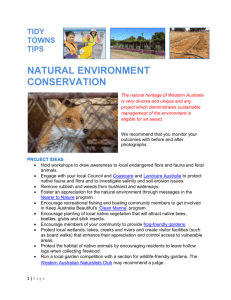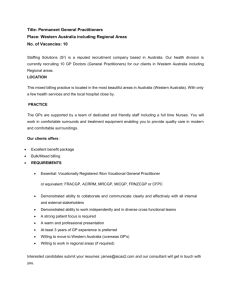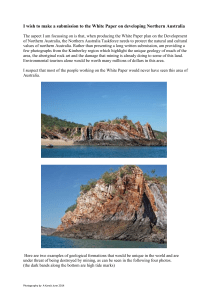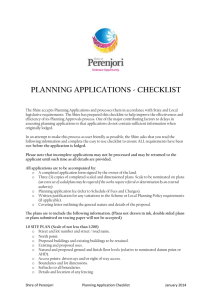DOCX: 339 KB - Department of Industry website
advertisement
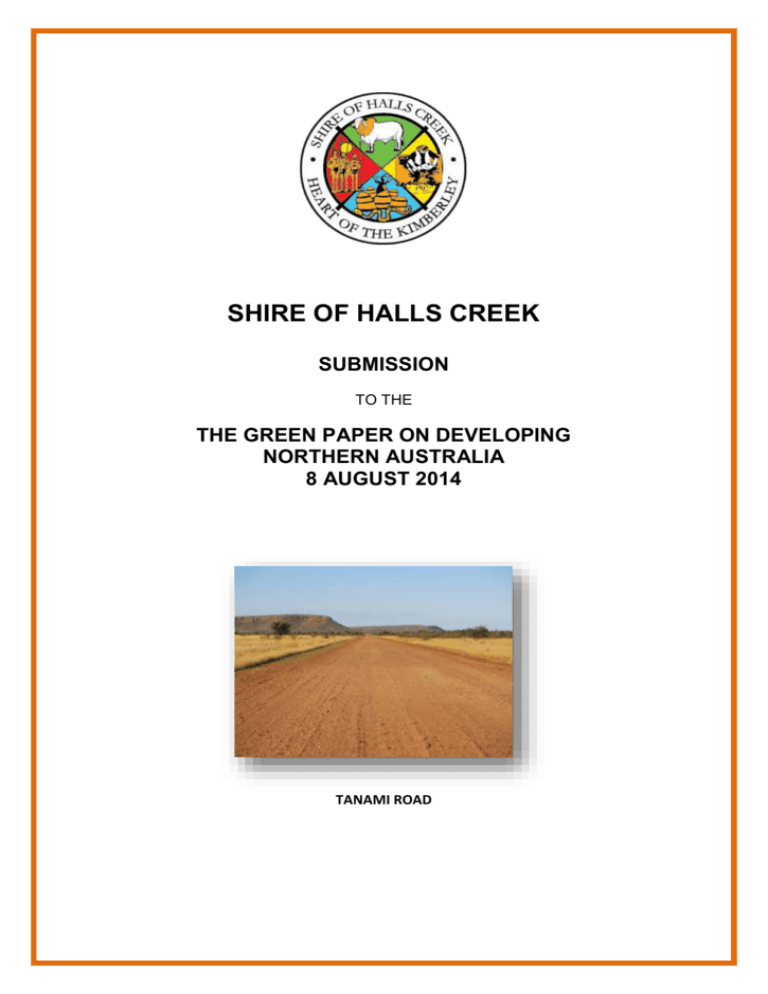
SHIRE OF HALLS CREEK SUBMISSION TO THE THE GREEN PAPER ON DEVELOPING NORTHERN AUSTRALIA 8 AUGUST 2014 TANAMI ROAD Green Paper on Developing Northern Australia Submission from Shire of Halls Creek 8 August 2014 Contents SUBMISSION SUMMARY Pg. 2 SECTION A: PROFILE OF NORTHERN AUSTRALIA 1. Are these the major characteristics of northern Australia? Pg. 2 SECTION B: OPPORTUNITIES FOR NORTHERN AUSTRALIA 1. Are these the major global and domestic trends that are creating opportunities for development in northern Australia? Pg. 3 SECTION C: BARRIERS TO DEVELOPMENT 1. Are these the major barriers to further economic development in northern Australia? What are the impacts on industries and communities? Pg. 8 3. What are the infrastructure limitations across northern Australia? Pg. 13 SECTION D 1. What are the right policy directions for further developing northern Australia? How can we support industry and community growth? Pg.15 5. In view of these policy directions what specific actions should be taken to develop northern Australia? By whom? Over what time period? Pg. 16 Appendices: Appendix 1: Letters of Support Appendix 2: CONFIDENTIAL, Report on the Economic Benefits of Upgrading the Tanami Road Deloittes Access Economics 1 Green Paper on Developing Northern Australia Submission from Shire of Halls Creek 8 August 2014 SUBMISSION SUMMARY: This submission is in response to the Green Paper on Developing Northern Australia. The Shire of Halls Creek welcomes the opportunity to make this submission which builds on our first submission and presentation to the Joint Select Committee on Northern Australia. The submission addresses a number of the matters raised in the Green Paper and focusses on what is considered to be one of the highest priority infrastructure projects for northern Australia, the bitumisation/sealing of the Tanami Road. The upgrade of the road will create a major arterial route for the nation, release the agricultural, tourism and mining potential in the region and increase the liveability and sustainability of the many remote communities and towns in the Kimberley. SECTION A: PROFILE OF NORTHERN AUSTRALIA 1. Are these the major characteristics of northern Australia? Demographics and Population: The Shire covers 142,908km2 of the Kimberley region. In the 2011 Census the Australian Bureau of Statistics estimated a total resident population of 4,031. The town of Halls Creek has a population of 1,443 and there are six other major Aboriginal communities scattered throughout the Shire - Balgo (pop. 508), Warmun (pop. 297), Billiluna (pop. 244), Ringer Soak (pop. 173), Mulan (pop. 136) and Yiyili (pop. 100). There are also nine smaller communities in the Shire. Aboriginal Representation was 78.2%, one of the highest proportions in Australia. Further to this the Kimberley and The Shire of Halls Creek in particular have a very high relative proportion of young people, as set out below. Age Shire of Halls Creek Australia 0 -10 years 19.9% 12.8% 10 – 25 years 27% 19.7% These demographics place particular pressure on the delivery of services to remote communities including health care, mental health, education and the provision of nutritional food. Mental health is a matter of high concern to the community. Alcohol harm and drug use are also issues in the region particularly amongst young people. The people of the Shire experience considerable social and economic disadvantages. We have a SEFIA (Socio-Economic Index for Areas) score of 598 which is in the lowest 1% nationwide, ranked 16th from the bottom in Australia and the lowest ranked in Western Australia. The indicators used to calculate the SEFIA scores include low income, low educational attainment and high unemployment. 2 Green Paper on Developing Northern Australia Submission from Shire of Halls Creek 8 August 2014 Youth unemployment is 17% compared to the national youth unemployment rate of 5.2%. The PHCAtlas (Population Health Commissioning Atlas prepared by Medicare Local Kimberley-Pilbara) has rated 50.9% of our children aged 0 to 5 years as developmentally vulnerable in 2 or more of the factors they measure. The national rate is only 11.8% and further to this we are one of the very few communities in which the rate is still rising. The Shire agrees that the matters raised in Section A, Population and Demographics, are the major characteristics of northern Australia however there are considerable differences between urban and regional/rural areas which need to be taken into account. Our own Shire typifies regional northern Australia as described in Section A of the Green Paper. • The land area is vast, • Population distributed sparsely • A very high proportion of Aboriginal and young people + High levels of social disadvantage These factors make the communities in regional areas very different to those in urban areas. The resulting needs and requirements for goods and access to essential service are very different to those living in larger centres. These differences need to be recognised and any economic development responses and initiatives tailored to the regional environment. In addition the current high levels of socio-economic disadvantage experienced by a significant number of the population in many parts of regional northern Australia needs to be factored into the characteristics. Whilst there have been and will continue to be responses from many different Federal and State government departments (under the COAG partnership agreements in particular) the issues around continuing social disadvantage will have an effect on the uptake and long term impact of economic development opportunities. SECTION B: OPPORTUNITIES FOR NORTHERN AUSTRALIA 1. Are these the major global and domestic trends that are creating opportunities for development in northern Australia? Economic Diversification: 3 Green Paper on Developing Northern Australia Submission from Shire of Halls Creek 8 August 2014 Mining: Mining is the largest economic contributor in the Kimberley region and in 2011 had an output valued at $1.159 billion. There has been a steady increase in mining over the last decade and the region is still being extensively explored and significant future discoveries can be expected. The region also contains significant deposits of gold and in the past two decades has emerged as a highly prospective gold province of national and global importance. The current low level of mining activity, while an important economic driver for the local community, does not reflect the full potential of the area’s geology. A report produced by ACIL Tasman (2003) identified the East Kimberley – Tanami region to be highly prospective for minerals, particularly in gold, platinum group minerals, nickel, lead-zinc, tantalum diamonds, and potentially petroleum. The mineral potential of the region is seen in the number of deposits situated on the Halls Creek mobile belt: • • • • • • Nicholson’s gold deposit – 60km west of Halls Creek; Palm Springs gold deposit – 3.5km southwest of Halls Creek; Savannah nickel mine – 240km south of Kununurra; Copernicus nickel mine – 35km south of Savannah; Argyle diamond mine – 214km north east of Halls Creek; and Koongie Park copper-zinc deposit – 25km south west of Halls Creek. The ACIL study found that the region is relatively under explored due to its geographical isolation, high cost of access, lack of infrastructure and services. Existing mining operations are planning for expansion in the future. Some examples include: Coyote Gold: Tanami Gold acquired the tenement in November 2003 from AngloGold. The mine was opened in 2006 after a 12 year planning phase. It initially had a production target of 60,000 ounces per year. In 2008-09, ore was mined in the Coyote Open Pit 1 and 2 as well as the Gonzales lode underground operation. It is intended that after the Coyote pit is exhausted, two other open pits will be mined, the Kookaburra and Sandpiper pits. Newmont Mining: Newmont's Tanami operations are at Callie mine at Dead Bullock Soak with the ore being processed at the Granites Mill 40kms to the east. The mine is significant by global standards and a major source of revenue for the NT Government, employment for NT people and enterprise for NT Businesses. Newmont has recently decided to exploit the Auron ore body that surrounds Callie, taking its life of mine to at least 2023, In 2011 Newmont commenced a $450 million deep shaft project aimed at extending the mine life, however in November 2012 the project was suspended with a refocus on performance of existing operations. The deep shaft project is scheduled to recommence in 2015. Tanami Gold: In 2010 Tanami Gold purchased the Groundrush (central Tanami) site from Newmont mining and is currently redeveloping the site with the aim of commencing production in the near future. The acquisition complements their Coyote Gold mine 90kms west, just across the border in WA. 4 Green Paper on Developing Northern Australia Submission from Shire of Halls Creek 8 August 2014 The level of exploration activity in the Tanami region which forms part of the Shire is low, both in absolute terms and relative to activity in the rest of the State. Less than 1% of the total expenditure for petroleum and minerals exploration in Western Australia has been spent in the region, despite the fact that Halls Creek Shire covers more than 10% of the prospective area for minerals in the state. One of the reasons given by the companies for lack of investment is the significant logistics costs due to the cost of transport over poor quality roads. As noted above both Newmont and Tanami Gold are undertaking significant exploration work at their respective sites. In addition the NT Geological Survey and Geoscience Australia undertook a major six year study of the geology of the region with the findings presented in June 2006. The project provided enhanced knowledge of the geology of the region and confirmed it as a major gold province. Despite these efforts, due to its remoteness and lack of all-weather infrastructure, the Tanami region is considered under explored. As one of the few gold provinces capable of producing multi-million ounce gold deposits, companies will continue to explore the region. For example, ERO Mining, ABM Resources and Ord River Resources all have significant exploration programs underway. In addition to gold companies Toro Energy Ltd are exploring for Uranium in the region and Northern Minerals is progressing its feasibility study for the mining of rare heavy earth in Browns Range. The evidence from mining operations in the Shire shows that the mining industry will continue to grow and diversify if the conditions for development are favourable. Planning for further exploration is underway and more development is planned for a variety of resources and mineral, including heavy rare earths which will open up a whole new set of global markets. It is vital that this industry continues to be supported and encouraged in northern Australia to grow and develop alongside other industries. The Shire considers that the best way to support this sector is the sealing of the Tanami Road which is discussed in more detail below. Agriculture: A large number of pastoral stations and the Ord River horticulture developments currently dominate agricultural production in the Kimberly region. There are some 140 agriculture establishments in the region, covering 12.7 million hectares of land. Pastoral Stations alone contribute approximately $200 million annually to the Kimberley regional economy. Each year 580,000 head of cattle are exported via the road network in heavy vehicles to Darwin Port. Road closures during wet periods impede heavy vehicle access, restricting the number of cattle that can be transported, business efficiencies and profitability. Load restrictions and closures due to flooded roads represent major obstacles for growth in this industry. The East Kimberly region is a centre of crop production, and the Ord River Irrigation Area is the largest irrigated project at 28,000ha. Located near Kununurra, crop production from the Ord River 5 Green Paper on Developing Northern Australia Submission from Shire of Halls Creek 8 August 2014 Irrigation Area was valued at $101 million in 2008/09 by the WA Department of Agriculture and Food. The largest component is sandalwood, accounting for more than $65.3 million. More recently, the region has attracted significant foreign investments for agricultural products. In 2012, the Kimberley Agricultural Investment, a Chinese owned Australian company invested $250 million in the construction of a sugar mill near Kununurra. The organisation plans to produce and harvest four million tonnes of cane a year with about 500,000 tonnes of export sugar being produced. The company also proposes to invest up to $700 million over a six year period to establish a sugar industry in Kununurra. Other primary industries including fishing, aquaculture and horticulture are growing businesses. The horticulture industry is worth $120 million a year alone to the Northern Territory. In addition, new agricultural projects in the La Grange area, the Fitzroy Valley, the Ord Valley and potentially the Flora Valley have huge potential to supply the heavily populated south eastern states. Existing agricultural operations and new ventures will all produce products and livestock that require a good road network to access international and domestic markets. Better access to the markets to the south and south eastern states along the Tanami Road will encourage more investment in agricultural diversification. Reliable access to port facilities for pastoral stations in the Kimberley will also encourage pastoral lease holders to diversify operations. Diversification may include the development of feedlots which will result in higher grade cattle exports. Current agricultural developments and plans support the trend for diversification in the agricultural sector. Foreign investment is growing and will encourage further diversification. A key to encouraging this diversification is creating a quality reliable conveyor belt for agricultural produce, be it crops or cattle, from the field to the market and the port. Tourism: The Kimberley Region also has a significant level of tourists visiting geographical and Indigenous cultural attractions. In 2010 tourism employed 2,171 people and generated $265 million with 235,000 tourists visiting the region. The Shire is the home of the Bungle Bungles (Purnululu World Heritage Park), Wolfe Creek Crater National Park, Paruku (Lake Gregory and the surrounding wetlands) and the Mimbi Caves. The Shire contains more artistic diversity and successful Aboriginal art centres than possibly any other shire in Australia. These include the distinctive ochre paintings of the Gija artists from Warmun, the acrylic paintings from Warlayirti Artists Centre at Balgo, and extend to emerging centres at Kundat Djaru, Mulan, Yiyili and Ngumpan. The future of tourism in the area is likely to build on the current ‘grey nomad’ market which consists of older Australian tourists traveling the Kimberley and the north. The aging population throughout Australia is likely to result in more tourists travelling the country and in particular the Kimberley. The trend of the ‘grey nomad’ travelling in a campervan or towing caravan around the region will 6 Green Paper on Developing Northern Australia Submission from Shire of Halls Creek 8 August 2014 continue to rise and with it the demand for better roads and access to the many natural and tourist attractions. Another new tourist opportunity which may open up with the Fly and Drive Adventure market (high spend), especially if planned direct flights from Melbourne to Kununurra goes ahead. The Shire agrees that development of tourism across northern Australia is an opportunity for economic development. The spectacular world renowned natural environment along with Aboriginal art and culture will draw more and more visitors to the region, particularly those from within Australia. To encourage this sector the Shire considers that the right roading infrastructure will be needed to ensure those contemplating the journey north feel confident and safe travelling. Indigenous Economic Development: Around 80% of the Shire’s population is Aboriginal; an increase in economic development for indigenous groups would therefore have a major positive impact on our community. In the 2011 census median weekly income was $312, compared to $662 for Western Australia. Only 27% of the population had completed year 12 (53% WA) and labour force participation was at 41% (64% WA). Youth unemployment (15 to 24 years) was 17% compared to only 5.2% for the rest of Australia. There is clearly an opportunity in this area for economic development. In the case of those living in remote communities in northern Australia there is however at present little chance of employment. Living on Country is an important part of Aboriginal culture and life. It is the tradition of Aboriginal people going back to live on their ancestral land whenever they can. Country is more than landscape and natural resources. In the Kimberley Aboriginal Caring for Country Plan Nulungu Centre for Indigenous Studies Country is described as follows: “Country is a cultural landscape with natural values. Aboriginal people come from Country and they maintain and practise their Law and language, which gives meaning to everything. Without these cultural aspects, Country is considered to be empty.’’ The reality of this is however that living on Country offers few employment opportunities as the settlements are remote and isolated. The opportunity and the needs exist for employment opportunities and economic development to occur on Country and close to settlements. One way this can be supported is by encouraging development of mining, agriculture and tourism in these remote areas. As noted above, this can be achieved by ensuring that the right infrastructure is there to support these economic sectors. Without reliable access to supplies and markets economic opportunities will not grow in remote regional northern Australia and employment close to Country will not increase. A considerable number of pastoral enterprises are leased and operated by Aboriginal companies. The opportunities for increasing agricultural production in general apply to these operations, and 7 Green Paper on Developing Northern Australia Submission from Shire of Halls Creek 8 August 2014 the same need for access to markets is essential particularly as they are some of the more remote stations in northern Australia. Growing agriculture will in turn provide more employment for those already living on Country and near the stations. Without reliable access tourists will not come to visit the incredible Aboriginal art galleries located throughout region. These centres are renowned throughout the world however access to them is very limited. The Art Gallery at Balgo sells paintings by Warlayirti artists supports over 200 Aboriginal artists in the communities of Balgo, Mulan and Billiluna. The paintings are sold throughout Europe and the US, mainly over the internet. Unfortunately visitor numbers are relatively few due to the isolation and the only access being the Tanami Road. Getting tourists and art buyers to the gallery would be a huge boost to the economic development of these communities. There is also a great opportunity for niche experience based tourism on Country where the traditional Owners already have most of the skills and knowledge required to take advantage of the higher number of tourists/market that would be available to target if the road infrastructure and ease of access was improved. Tours of Aboriginal sites with dreamtime stories are remarkable experiences that tourists are seeking and willing to pay a premium for and such employment opportunities allow the traditional owners to work and live on Country. The Shire agrees that there is a huge opportunity for Indigenous economic development in northern Australia. Many employment opportunities will eventuate from growth in mining, agriculture and tourism close to those living on Country in remote settlements. Further to these opportunities there is a huge market for both Aboriginal art which is already being sold from galleries in the settlements and on Country cultural tourism. Reliable access to these remote areas where many of the Aboriginal population live will be essential to realising the potential of these enterprises. SECTION C: BARRIERS TO DEVELOPMENT 1. Are these the major barriers to further economic development in northern Australia? What are the impacts on industries and communities? Remoteness, climate and liveability: The town of Halls Creek is 2,850 km from Perth, 684km from the nearest regional city at Broome and 359km from the nearest Regional Centre at Kununurra. All the settlements in the Shire, including the town itself, are classified as Very Remote under the ARIA+ (Accessibility/Remoteness Index of Australia). Very remote means the Shire is disadvantaged by its location, with very little access to goods and services (health, retail, education, and social services). As noted in the Green paper our climate is harsh and seasonally variable. Using Bureau of Meteorology data the mean maximum temperatures over a year can range from 27.2oC to 38.2oC. Mean rainfall is lowest in August at 1.9mm and highest in January at 152.9mm. The wet season runs generally from December to March and total mean rainfall for the Shire per year is 571.8mm. 8 Green Paper on Developing Northern Australia Submission from Shire of Halls Creek 8 August 2014 All goods and services are delivered to and within the Shire by road – except for emergency medical services which are provided by air. This increases the cost of living in both the town of Halls Creek and the remote communities along the Tanami. The costs associated with the transport of goods and services are high and one of the major factors in the high cost of living. The combination of remoteness and a harsh climate, in particular, the 3 month wet season, have a considerable impact on the liveability of the area. Remote communities along the unsealed Tanami and Duncan Roads are regularly cut off during the wet season, which means supplies and services must be flown into the communities. Services such as regular medical treatment and services provided by the Shire itself are severely disrupted. The cost of flying in supplies is extremely high. In addition basic utility services such as electricity can be threatened if road closures are for extended periods which can prevent generator diesel supplies reaching the communities. The average number of days per year that the Tanami Road is closed is 24 (2005 – 2013). The town of Halls Creek can also be isolated by flooding on the Great Northern Highway which is the only sealed road linking Halls Creek to the regional centre of Kununurra, Broome and the Northern Territory. The Regional Price Index 2013 outlines the relative differences in communities around Western Australia and shows the high cost of living in the Shire. Town Price Index Shire of Halls Creek Kimberley Region Pilbara Region Wheatbelt Region Region and Town Price Indices Food Commodity Group Housing Commodity Group 116.6 114.7 118.6 100.5 130.3 114.5 101.5 103.6 122.4 125.6 139.8 96.1 The high cost of even the most basic services has a considerable impact on the poorest in the Shire, particularly those in the most remote areas. It also decreases the attractiveness of the Shire as a place to live and work. Attracting staff for professional and services roles from outside the Shire is difficult and this in turn can limit the services provided in the Shire. The Shire agrees that these factors are major barriers to economic development, and the impacts include high costs for delivering services, high costs of living and isolation. These factors all contribute to making life in northern Australia extremely difficult for local people and also look unattractive to those living outside the area considering moving here. This in turn impacts on service delivery and the level of service provided to the local community. 9 Green Paper on Developing Northern Australia Submission from Shire of Halls Creek 8 August 2014 Infrastructure: As noted above roading is one of the most significant contributors to the lack of liveability and high cost of living in the Shire, in particular for the remote communities. In the Shire the condition of the Tanami Road is considered a significant barrier to economic and community development. In the Northern Territory the road is managed by the Northern Territory Government. In Western Australia it is managed as a local road by the Shire of Halls Creek. The Tanami Road is 1,010km long with 753km remaining unsealed between Halls Creek, WA and Yuendumu, NT. This unsealed section covers both sides of the Western Australian and Northern Territory borders. The road condition along the 703km section of the Tanami Road from the Stuart Highway turn off 19km north of Alice Springs to the WA Border comprises 220.5km sealed and 482.5km unsealed road. The first major town of Yuendumu is 269km from the Stuart Highway turnoff. Similarly from the WA border to Halls Creek the road is unsealed to the first major town of Balgo and for virtually all the rest of the road to the Halls Creek turnoff. Communities: There are three main Aboriginal communities along the Tanami Road in the Shire – Balgo, Billiluna and Mulan. For these settlements the Tanami Road is the only link to the rest of the Shire and the region. All goods and services come into the settlements by road transport. Just as importantly the road is the only route for those living in the communities to access medical treatment, attend essential cultural occasions and visit with family living away from the community. The condition of the road significantly affects the condition of vehicles using the road regularly and vehicle maintenance is a burden on the limited economic resources of those living there. Providing support for the work of the arts centres along the Tanami Road will not only preserve the unique indigenous cultures of the region but also provide essential opportunities for participation in the economy. A letter received letter from Warlayirti Artists Centre highlights about the issue about the condition of the Tanami Road and the deleterious effect that the condition of the road was having in the community (2009). "This art centre supports over 200 indigenous artists in the communities of Balgo. Mulan and Billiluna. Other than Centrelink payments and CDEP it is the major provider of the income for many of these artists. In 2007-2008 it contributed $1.5 million in direct payments to artists across these communities. The Art Centre generates considerable money for the entire Halls Creek Shire... For the Art Centre in a time of recession we need as many people travelling to the art centre as possible to generate income for the artists and their families. The condition of the road is discouraging the normal tourist travel to the community." Mining: The lack of exploration and other mining developments have often been attributed to two main factors. • The higher cost of transport to supply the mine and transport minerals; and 10 Green Paper on Developing Northern Australia Submission from Shire of Halls Creek 8 August 2014 • The lack of local infrastructure and services to support the mining operation in the region Newmont Mining stated in 2013 that the current state of the road adds approximately $6-8 million to annual operations. For example: In 2012 their fuel provider placed a 4.58 cents per litre surcharge on cartage to cover additional maintenance costs, equating to additional costs of $2.3 million per annum; and An equipment provider stated road upgrades would save approximately 3,000 hours per year of travel, equating to being able to remove one truck from the service, saving approximately $100,000 per year. Tanami Gold had lost revenue of $75 million from 2009/10 to 2010/11 due to road closures associated with flooding and they estimate costs to them of rescuing stranded travellers is approximately $100 000 per year. As the only direct supply route between the Red Centre and the East Kimberly region, the Tanami road plays an important role in the development of mining activities in the region. The Tanami road is highly unreliable during wet seasons, as it can be inaccessible over extended periods of time due to flooding or other adverse weather conditions. This exacerbates the uncertainty businesses face in the region, particularly in relation to continuity of supply, and the ability to transport products from the mining sites to other regions for processing and export. In addition, road closures also affect the ability and cost of local businesses to service mining operations in the area. Services provided by indigenous communities along the Tanami are particularly prone to such adverse conditions, as they are likely to be not accessible. Prolonged inaccessibility and lack of income to these community businesses decreases their likelihood of being a viable going concern. Further, poor road conditions on the Tanami substantially increase the operating cost of mining operations by raising transport costs. Vehicles travelling along the Tanami Road require constant maintenance and repair, the extreme roughness of the road also implies that vehicles have a significantly shorter lifespan operating on the Tanami than a sealed highway. Excessive overhead cost deters low yield prospective mining investment in the region. Agriculture: The current state of the Tanami limits the movement of agricultural products to markets in the south and southeast states. At present agricultural produce from the Kimberley going to markets in the south must either travel out to Broome, down the west coast and then travel across the Nullarbor or travel through Kununurra, up to Katherine and down the Stuart Highway through Alice Springs. The shortest alternative route is over 1,000kms longer than using the Tanami Road and represents a significant cost in both time and money which has to be passed onto the consumer or borne by the 11 Green Paper on Developing Northern Australia Submission from Shire of Halls Creek 8 August 2014 producer. This is a major consideration for those contemplating diversification and intensification on land in the Kimberley Region. Tourism: The unsealed Tanami Road presents a challenge to the average tourist travelling around Australia. Unsealed roads are perceived to be, and are in fact, a significant risk to vehicles and personal safety. Anecdotal evidence from visitors to the Halls Creek Travel and Tourism Centre confirms those traveling with lighter vehicles or towing caravans are unwilling to risk the journey. Poor road quality and unreliable road access has been a key barrier for tourism in the region. During wet seasons, the road can be closed for months at a time. Even when accessible, poor road conditions are often hazardous for inexperienced travellers. Furthermore, stretches of the road are badly corrugated, making it extremely difficult for light tourist vehicles. The lack of development in the region also means that there’s a lack of roadhouses for supply along the road. Consequently those making the trip need to carry ample supplies of fuel, food and water. Since the closure of Rabbit Flat Roundhouse, the longest portion of the road without supplies is 586km, making the trip more risky. In addition there is no discernable circular route through the NT and around the Kimberley. The current choice is a one way long distance journey from Alice Springs to Katherine and down through Kununurra to Halls Creek and away to the coast. Tourists have to decide if they will back track, continue around Western Australia to return home or miss out the Kimberley and Western Australia all together. Sealing the Tanami Road and providing a circular route through the Kimberley and Northern Territory will potentially increase tourism to both states by increasing available options and encouraging return visits for those who did not visit the Kimberley, or are looking for new experiences (such as the Tanami and the remote communities). This limits the economic return from tourists on the route especially the remote communities along the route. The Shire of Halls Creek considers one of the most significant barriers to the economic development of northern Australia (and the single most significant barrier in the Shire itself) is the current condition and state of the Tanami Road. The current condition impacts on all sectors of the economy discouraging investment in existing and future mining, agricultural and tourism. Those people living in the remote communities are also impacted by the condition of the road by the higher costs of goods and services, few health and social services, isolation in the wet season and general isolation. 12 Green Paper on Developing Northern Australia Submission from Shire of Halls Creek 8 August 2014 3. What are the infrastructure limitations across northern Australia? The Tanami Road is a major limitation to development in northern Australia. The condition of the road means that there is only one viable reliable route from the south to the north and north-west and that is using Victoria and Stuart Highways. This situation means that: • • • • • Liveability is substantially lower than other areas in Australia because of the high cost of living (including the cost of freight for all goods) and doing business; Development of mining, agriculture and tourism is limited in the Shire and throughout the Kimberley as a large part of the Shire is not served by a sealed road; Freight logistics are limited with no alternative route providing access for products from the Kimberley Region to the lucrative markets in the south-eastern states; Connectivity to remote Aboriginal Communities is severely constrained due to costs to government of delivering and maintaining infrastructure and services in local communities; Interstate connectivity is limited; and Defence Forces have only one (indirect) route for deploying forces from the southeast for border security, disaster relief and aid to our northern neighbours. The road consists of Type 1, Type 2 and Type 3 construction formations – that is unformed road, formed construction without a gravel surface and gravel road. Over two thirds of the Tanami Road is unsealed with substantial sections being unformed. Continual grading has resulted in the road dropping well below the surrounding land surface and this has lead to increased flood damage and associated closures and safety risks. The current condition of the road causes the Tanami Road to be fully closed or restricted to heavy vehicle traffic for lengthy periods during the rainy season, limiting mobility and access to communities which are situated off the Tanami Road. During the drier periods, there are inherent safety issues for road users arising from poor geometry, excessive corrugations, and poor visibility through excessive dust generation. The excessive dust generation also has an environmental impact on land along the road and a health impact for those living in communities along the road. The general condition of the road deters most freight companies from using the road at any time of the year and when they do use the road their costs reflect the increased time and vehicle maintenance costs. There are sections of the road that require speeds as low as 10 km/hr for freight transports. This is a necessary safety precaution and it has a significant impact on delivery times and freight costs. The use of the road by road trains often creates significant ruts that are dangerous for other transport. As discussed above it limits investment and the expansion of the mining, agriculture and tourism sectors. 13 Green Paper on Developing Northern Australia Submission from Shire of Halls Creek 8 August 2014 The following table outlines the number of weather related road closures over recent years in both the Northern territory and the Shire of Halls Creek. Table 1 – Number of weather related road closures per year 2005-2012 Number of days of closures (defined as officially closed or impassable) Number of days of restrictions (defined as axle load restrictions) and in addition to closures NT Year 2005 2006 2007 2008 2009 2010 2011 2012 2013 Average / yr Number of days of closures 30 72 40 5 17 57 34 8 24 32 WA Number of days of restrictions 0 65 132 67 62 11 22 1 0 40 Number of days of closures N/A N/A N/A N/A N/A N/A N/A 24 24 24 Number of days of restrictions N/A N/A N/A N/A N/A N/A N/A 5 0 3 An example of the limitations of leaving the Tanami unsealed can be found in the mining industry. The importance of access to quality roads for mining activity can be seen by analysing the road access of Australia’s operating mines. 381 of Australia’s 419 operating mines are within 10km of a highway quality road – that is 91% of operating mines. Of those not near a highway quality road, 3 are within the Tanami region (and not all of these are currently operating). That is, the Tanami region alone accounts for 10% of Australia’s operating mines that do not have access to a good quality road. 14 Green Paper on Developing Northern Australia Submission from Shire of Halls Creek 8 August 2014 On a nationwide scale the condition of the road limits access to the northwest of the country from the south. The travel distance between Halls Creek and Alice Springs is 2,145 kilometres via the currently preferred sealed route of the Victoria and Stuart Highways. The Tanami Road in its current condition is not a viable alternative even though the route is 1,135km shorter in distance. The Defence Force Posture Review conducted in 2011/12 recognises that Australia has a range of strategic interest to safeguard and advance in the north-west. These include: • • • • • • Responding to the growing strategic importance of the Indian Ocean region. Maintaining and enhancing Australia’s capacity to provide humanitarian aid in the region and in particular, to maintain a special relationship with Timor Leste. Border security. Disaster relief response capacity. Joint defence force exercises with neighbours and allies. Protection of both valuable wealth producing assets and the population of the region The lack of an alternative shorter route to the north-west means that the supply route for the defence bases in the north-west from the population centres of the south-east is vulnerable. In time of high military tension having only one realistic access route to the north-west could cause major strategic and security issues. The Shire of Halls Creek considers that the condition of the Tanami Road is a major limitation for northern Australia. Currently it is not a viable, economical or secure route for the mining, agriculture and tourism sectors to use and this limits the development of these sectors. At present there is only one viable all year round route from the south into the north and into the Kimberley region. The distances that freight has to travel to get into the northwest and the Kimberley increases both the time taken to get goods to the destinations and the cost of those goods. Ultimately this impacts on the Shire of Halls Creek, the town and remote communities by decreasing liveability by increasing living costs and making service delivery difficult. In addition the lack of an alternative direct route from the south-east can be a problem for Defence Forces deploying troops and supplies into the north-west. SECTION D 1. What are the right policy directions for further developing northern Australia? How can we support industry and community growth? The Shire considers that providing policy which encourages the planning and provision of the right Infrastructure in the north is crucial to supporting both industry and community growth. The example of a project like the sealing of the Tanami Road delivers numerous benefits to northern Australia. 15 Green Paper on Developing Northern Australia Submission from Shire of Halls Creek 8 August 2014 • Increases Liveability - substantially cut costs of living and doing business along the Tanami Road and across the Kimberley Region; • Economic Development - enhances regional economy via productivity improvements flowing from improved access to land for mining exploration, land and markets for cattle and other pastoral sectors and to the natural and cultural wonders of the region for tourism. • Enhances freight logistics providing improved access for products from the Kimberley Region to the lucrative markets in the south eastern states and cities such as Alice Springs, Adelaide and Melbourne; Enhances and secures a direct route from the south-east for the deployment of Defence Forces for border security, aid distribution and other military requirements; • Delivers on Closing the Gap targets by creating opportunities that are important to Aboriginal people in the region, including enhanced access to employment and enterprise; their Country for cultural obligations; education (easier to access schools that are cheaper to construct and maintain); and health facilities and services through quicker and safer travel times and reduced costs; • Enhances connectivity to remote Aboriginal Communities and this would reduce the cost to government of delivering and maintaining infrastructure and services in local communities including expenditure associated with government payments such as the dole and pension; • Enhances Interstate connectivity; and • Improves road safety. The Shire considers the commissioning of work by COAG to look at ways to prioritise projects that improve productivity or unlock economic growth potential is encouraging. The benefits of projects such as the sealing of the Tanami Road are wide ranging and are not always captured by traditional cost benefit considerations. Looking at the respective roles of government and the private sector is also endorsed as this can have a considerable impact on the feasibility of an infrastructure project, including looking at the way the private sector pays to use infrastructure such as tolling commercial users of new roads. 5.. In view of these policy directions what specific actions should be taken to develop northern Australia? By whom? Over what time period? Given the importance of infrastructure in contributing to the development of northern Australia the Shire considers that the sealing of the Tanami Road should be prioritised and funded by the Federal Government. The benefits to the communities along the Tanami, the Shire of Halls Creek, the Kimberley, the north- west and the rest of Australia are outlined above. The provision of a second sealed road from Alice Springs to Halls Creek is vital in order to release the potential of mining, 16 Green Paper on Developing Northern Australia Submission from Shire of Halls Creek 8 August 2014 agriculture and tourism in the Kimberley. In particular the sealing of the Tanami would shorten considerably the distance, time and cost of all forms of transport from and to the south and south east. Furthermore it would help overcome the isolation and high cost of living in the Shire which represents a large portion of regional northern Australia. As noted in the Green Paper (p.46) the Tanami Road upgrade is one of the projects which has very strong Stakeholder support. The Shire considers the support of the community and other stakeholders as being vital when it comes to major infrastructure projects such as this. Since our initial submission to the Joint Select Committee many more stakeholders who support the Tanami Road upgrade have sent in letters of support. Those letters are attached to this submission (Appendix 1). They show widespread support from a wide range of stakeholders and community groups including mining operators, Aboriginal communities along the road, the Kimberley Land Council, pastoral station owners and regional development agencies as well as political leaders. The Shire has commissioned a report from Deloitte Access Economics on the economic benefits of upgrading the Tanami Road. A copy of this report is attached as part of this submission for the Inquiry to consider. However the report must remain confidential to the Inquiry (confidential Appendix 2). This is an initial report only and subject to change subject to discussion with Infrastructure Australia. In summary the incremental benefits from upgrading the Tanami Road total around $220m in Net Present Value (NPV) terms. This is compared to the capital costs of around $290m in NPV terms. Together these give a cost benefit ratio of 0.76. The Shire will be seeking funding for the project from the Federal Government given its strategic importance. An indicative business case is currently being presented to Infrastructure Australia in which the case for tolling has been indicatively examined by Cranleigh, an Australasian consultancy firm. The analysis looked at the tolling vehicle movements on a one-off toll per movement and also charging tolls on a per kilometre basis, or a mileage toll. Both methods showed that tolls could make a significant contribution towards reducing the negative NPV of the whole of life costs of a sealed Tanami Road. It was noted that the elasticity of demand relating to tolling was not investigated and this needs to be as part of the full business case. The cost of establishing and maintaining toll gates was also not been included. Given the remoteness of the Tanami Road, tolling booths are unlikely to be practical. Possible options include use of remote cameras and potentially the use of shadow tolls. The potential revenue collection and associated collection costs will be investigated as part of the full business case. 17 Green Paper on Developing Northern Australia Submission from Shire of Halls Creek 8 August 2014 The upgrading and sealing of the Tanami Road is vital to the future development of the Kimberley region and northern Australia. It is the key to unlocking the full economic potential of the Kimberley providing a direct all weather arterial route to and from the southern and south eastern states. The project has the full support of numerous stakeholders in the Shire, the region and the State along with others in the Northern Territory. It will facilitate and encourage the diversification of the economy: Mining – Improved access and reduction in costs Agriculture – support growth, diversification and sustainability Tourism – Increase tourist numbers and diversity Defence – improve access and security in the North This will in turn provide economic development and employment opportunities for Aboriginal communities in the area. The project will increase the liveability and sustainability of all the communities in the Shire of Halls Creek reducing the cost of living and isolation. The Shire is currently presenting a submission to Infrastructure Australia (IA) for project funding and will be undertaking a full business case to submit to IA by the end of the year. That business case will include examination of tolling vehicle movements to reduce the whole of life costs of the project. The Shire of Halls Creek, along with many local, regional and national stakeholders, consider this project to be the most important infrastructure project for the future of the Shire, the Kimberley region and northern Australia. We urge the Select Committee to include the sealing of the Tanami Road as a project to be commenced in the next 2 to 5 years in the White Paper. 18
